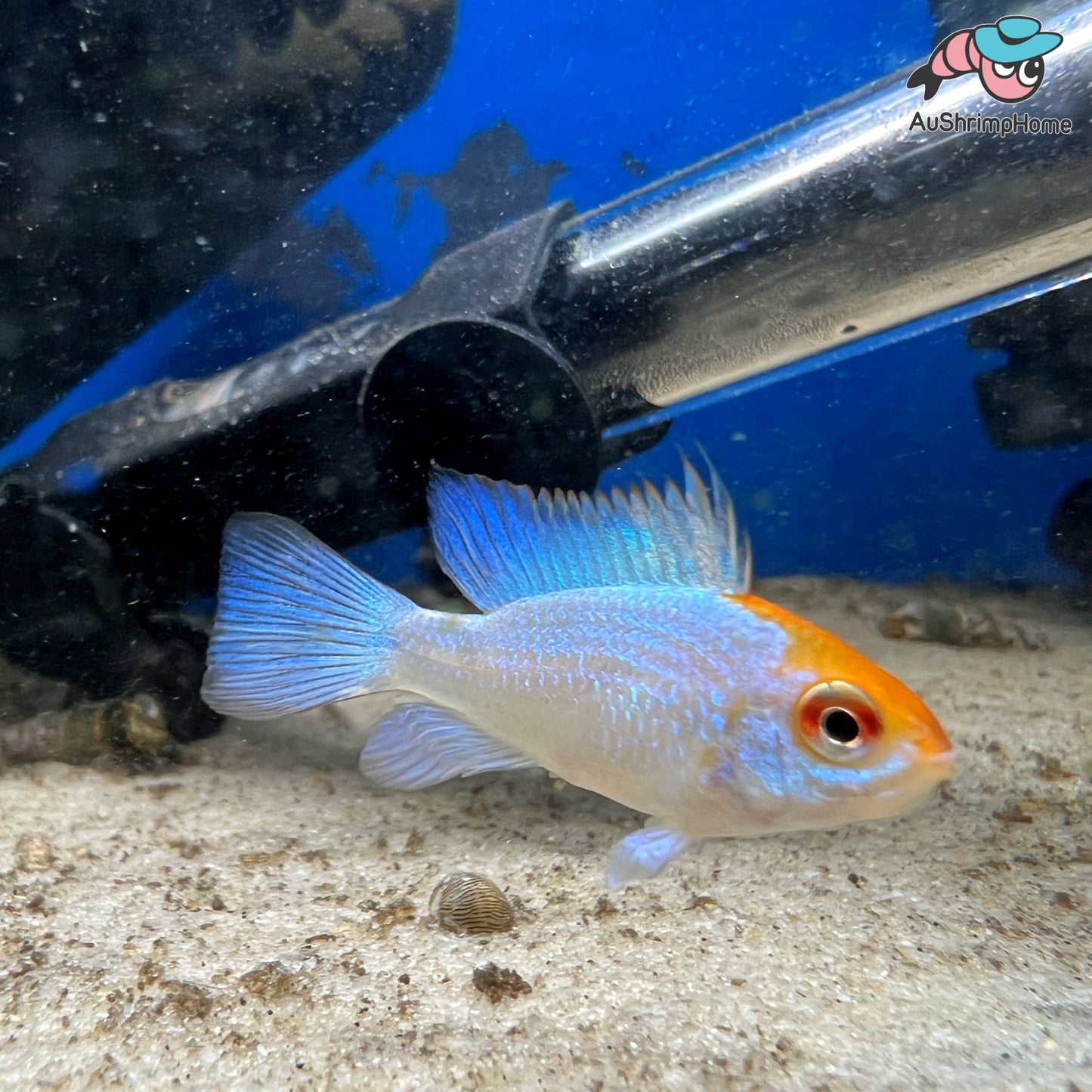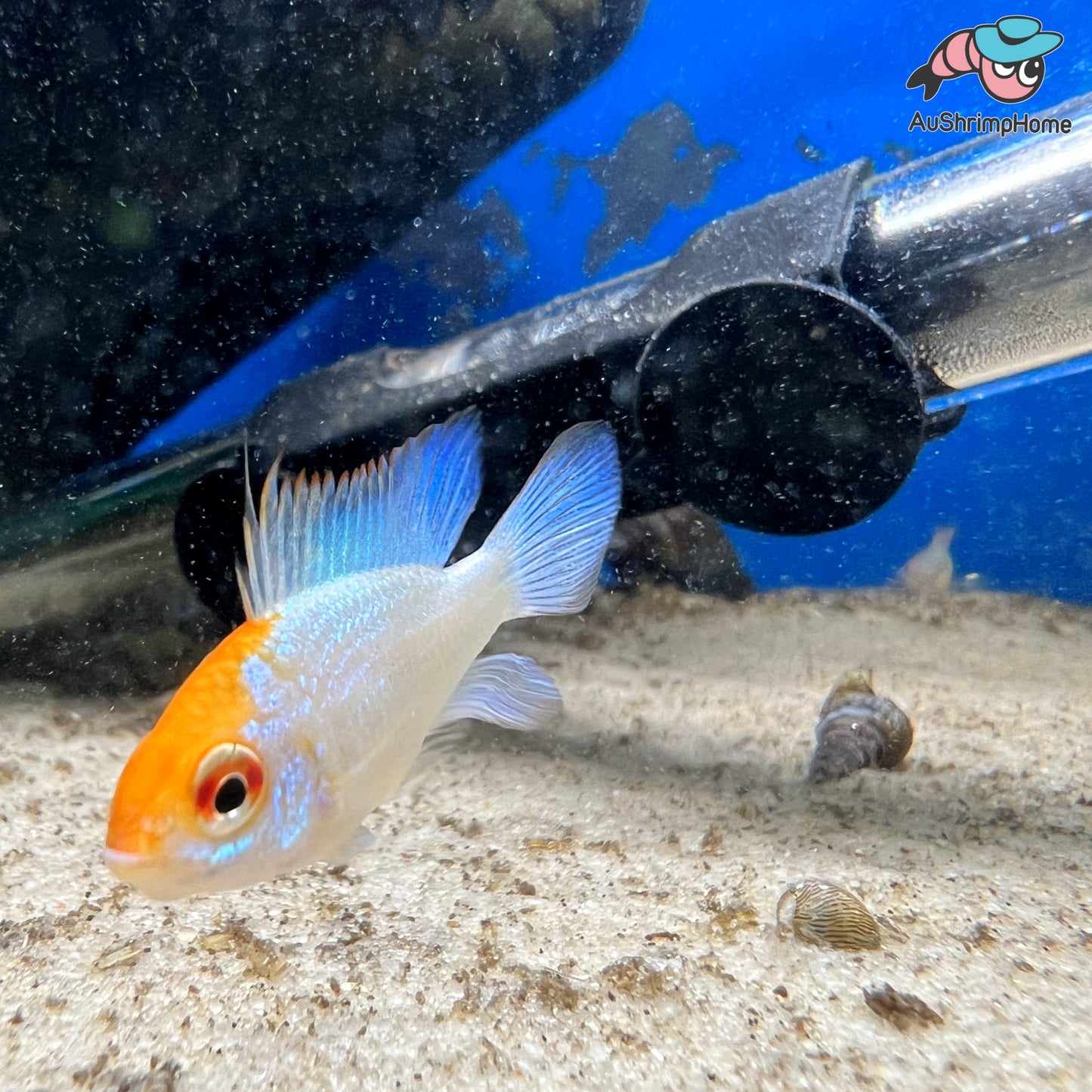Neon Blue Golden Head Ram
Neon Blue Golden Head Ram
Out of stock
Couldn't load pickup availability
Neon Blue Golden Head Ram, also known as the Electric Blue Ram or the German Blue Ram (Mikrogeophagus ramirezi), is a captivating freshwater fish prized for its vibrant colors and distinctive appearance. Here’s an overview of this popular aquarium species:
Physical Characteristics:
- Coloration: The Neon Blue Golden Head Ram displays striking hues of electric blue across its body, with a golden-yellow head and chest. This coloration is more intense in males, especially during breeding.
- Size: Adults typically grow to about 2-3 inches (5-7.5 cm) in length, making them a relatively small but eye-catching addition to aquariums.
- Fins: They have elongated dorsal fins and rounded bodies, contributing to their elegant and streamlined appearance.
Natural Habitat:
- Native to the slow-moving rivers and tributaries of South America, particularly in the Orinoco River basin and parts of Venezuela and Colombia.
- Rams prefer densely planted areas with sandy or fine substrate, where they can sift through for food and find hiding spots among driftwood and rocks.
Behavior:
- Known for their peaceful temperament, Rams are generally considered community-friendly fish but can be territorial, especially during breeding periods. They should be kept with other peaceful species.
- Rams are intelligent and interactive fish, often exploring their surroundings and displaying intriguing behaviors.
Tank Requirements:
- Tank Size: A minimum tank size of 20 gallons (75 liters) is recommended for a pair of Rams. They appreciate tanks with plenty of swimming space and hiding spots.
- Water Parameters: Rams thrive in slightly acidic to neutral water conditions (pH 6.0-7.0) with a temperature range of 78-85°F (25-29°C). Stable water parameters are crucial for their health and well-being.
- Aquascape: Provide a well-planted aquarium with driftwood, rocks, and caves to mimic their natural habitat. Soft, sandy substrate is ideal for them to sift through in search of food.
Diet:
- Neon Blue Golden Head Rams are omnivorous and require a varied diet. They will accept high-quality flakes, pellets, and frozen or live foods such as bloodworms, brine shrimp, and daphnia.
- Supplement their diet with vegetable matter, such as blanched spinach or zucchini, to ensure nutritional balance.
Breeding:
- Breeding Rams can be challenging but rewarding. They are substrate spawners, with pairs forming strong bonds and actively caring for their fry. Provide flat surfaces like rocks or broad leaves for spawning, and maintain stable water conditions to encourage breeding behavior.





More Information
How to Take Care The Shrimps
Taking care of Freshwater aquarium Shrimps (Neocaridina and Caridina) involves providing them with a suitable environment and proper attention to their specific needs. Here are some essential care guidelines:
1. Tank Setup:
- Shrimp are relatively small and can be kept in tanks as small as 5 gallons (19 liters), but a larger tank allows for more stable water conditions.
- Provide hiding spots with plants, driftwood, and rocks. Live plants like Java Moss and Java Fern are ideal as they serve as both hiding places and a food source.
2. Water Parameters:
For Neocaridinar (Cherry Shrimps)
- Temperature: 72-78°F (22-28°C)
- pH: 6.5-7.5
- GH (General Hardness): 6-10
- KH (Carbonate Hardness): 3-10
For Caridina (Taiwan bee, Crystal Shrimps)
- Temperature: 72-78°F (22-26°C)
- pH: 6.0-6.5
- GH (General Hardness): 3-5
- KH (Carbonate Hardness): 0-10
3. Filtration:
- Use a sponge filter such as Qanvee filter or a gentle flow filter to avoid strong currents that can stress shrimp.
4. Feeding:
- Shrimp are omnivores and feed on algae, biofilm, and commercial shrimp pellets.
- Supplement their diet with blanched vegetables like Mulberry leaves, spinach or zucchini.
- Offer a varied diet to ensure proper nutrition.
5. Water Changes:
- Perform regular water changes (10-20% weekly) to maintain water quality.
- Use dechlorinated water at the same temperature and parameters as the tank.
6. Molting:
- Provide a calcium source, such as our shrimp mineral products or crushed coral, cuttlebone, to support molting.
7. Tank Mates:
- Shrimp are generally peaceful but can be preyed upon by larger fish.
- Suitable tank mates include small, non-aggressive fish like guppies or endlers.
- Avoid aggressive or predatory species.
8. Breeding:
- Shrimp breed readily in captivity.
- Provide moss or other dense plant growth for shrimp to hide their eggs.
- Maintain stable water conditions to encourage breeding.
9. Health and Observation:
- Regularly observe your Shrimp for signs of stress, illness, or abnormal behavior.
- Quarantine new arrivals to prevent introducing diseases.
10. Patience:
- Shrimp keeping can be rewarding but requires patience. Allow your aquarium to mature and stabilize before adding shrimp.
By following these care guidelines, you can create a thriving environment for your Shrimp and enjoy their vibrant colors and fascinating behavior in your aquarium.
How to Acclimate New Shrimps & Fish
Acclimating new aquarium shrimp/fish is crucial to ensure a smooth transition and minimize stress. Follow these steps for proper acclimation:
Materials Needed:
- A container or bucket.
- An airline tube or a slow-drip system (optional).
- A net.
Procedure:
- Turn Off Lights: Dim the aquarium lights or turn them off completely to reduce stress on the shrimp/fish.
- Float the Bag: Place the sealed bag containing the shrimp on the surface of the aquarium water. This allows the water inside the bag to gradually adjust to the tank temperature.
- Drip Acclimation (Optional): If you have an airline tube or a slow-drip system, set it up to provide a gentle flow of water from the tank into the bag. This method is slower but provides a more gradual transition. Adjust the flow rate to about 2-4 drops per second.
- Monitor Temperature: Ensure the water temperature inside the bag matches the tank temperature after about 15-20 minutes. This step is essential to prevent temperature shock.
- Open Bag and Add Tank Water: Carefully open the bag without allowing shrimp to escape. Using a net or your hand, gently transfer the shrimp into a clean container or bucket. Be cautious not to introduce water from the bag into the container.
- Gradual Water Exchange: Over the course of about 30 minutes to an hour, gradually add small amounts of aquarium water to the container with the shrimp/fish. This helps the shrimp adjust to the tank's water parameters.
- Net Transfer: After acclimation, use a net to transfer the shrimp from the container into the main aquarium. Avoid adding any water from the acclimation container into the tank.
- Dispose of Bag Water: Safely dispose of the water from the bag. Do not release it into your aquarium, as it may contain contaminants or pathogens.
- Observe and Monitor: Keep an eye on the newly introduced shrimp/fish for the next few hours to ensure they adapt well to their new environment. Monitor their behavior and look for any signs of stress or illness.
Proper acclimation helps reduce the risk of shock and ensures a smoother transition for your new aquarium creatures. It's an essential step in ensuring their health and well-being in your tank.
Shipping & DOA Policy
- Concerned about purchasing livestock online? Rest assured, we ship shrimps and other livestock to every corner of NSW, VIC, QLD, and SA weekly, ensuring their safe and healthy arrival. Our Dead on Arrival (DOA) policy is applied to all orders, guaranteeing your peace of mind.
- Shrimps are carefully packed in a styrofoam box and shipped every Monday/Tuesday/Wednesday early morning to avoid weekend delays. Delivery times generally range from 1 to 3 business days depending on your location.
- To initiate DOA claims, we kindly ask buyers to contact our dedicated support team either via email at aushrimphome@gmail.com or directly through our website's chat feature. In order to expedite a swift resolution, which may involve resending a new package, issuing a refund, or providing credit for a future order, we kindly request that buyers submit a clear photo of the deceased shrimp(s) inside the unopened bag within a maximum of 1 HOUR from the moment of Australia Post delivery. Your timely communication is pivotal in enabling us to promptly address any concerns and uphold our unwavering commitment to ensuring your satisfaction.
Important Notes Before Buying
- Please note that our ornamental shrimps are small, with a maximum size of around 2cm. When purchasing, you'll typically receive juveniles or sub-adults measuring approximately 0.8-1.5cm, which may display less vibrant coloration than adults. However, rest assured that they originate from the same colony and offer excellent value for your investment.
- To ensure the well-being of your shrimp/fish upon arrival, please follow the tracking number and acclimate them by slowly adding tank water to their bag/container for about one hour. This gradual transition helps them adapt to new water parameters and temperatures.
- The images featured on our website showcase the exceptional individuals and actual shrimps/fish thriving at our facility. However, please keep in mind that as living organisms, we cannot guarantee that the shrimp/fish you purchase will be identical in color and size. Keep in mind that shipping stress may temporarily affect the shrimp's coloration, especially neocaridina species, which can become pale and translucent. However, their colors will return to their vibrant state within a few days under suitable water conditions.
- Our pricing is based on current stock levels and market rates in Australia. We regularly adjust our prices to provide our customers with the most competitive rates available.
- If you encounter any issues with the color or quality of the shrimp/fish, please don't hesitate to reach out. We are committed to assisting and resolving any concerns. Thank you for your trust and support!





